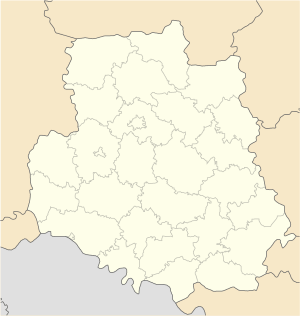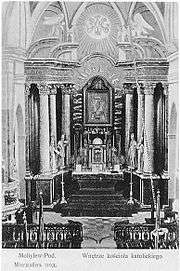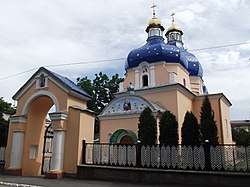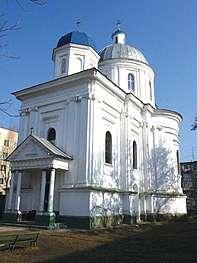Mohyliv-Podilskyi
Mohyliv-Podilskyi (Ukrainian: Могилів-Подільський, Russian: Могилёв-Подо́льский, Polish: Mohylów Podolski, Romanian: Moghilău/Movilău, Yiddish: מאָהילעװ) is a city in the Mohyliv-Podilskyi Raion (district) of the Vinnytsia Oblast (province), Ukraine. Administratively, Mohyliv-Podilskyi is incorporated as a town of regional significance. It also serves as the administrative center of Mohyliv-Podilskyi Raion, one of twenty-seven districts of Vinnytsia Oblast, though it is not a part of the district. It is located in the historic region of Podolia, on the border with Bessarabia, Moldova, along the left bank of the Dniester river. On the opposite side of the river lies the Moldovan town of Otaci, and the two municipalities are connected to each other by a bridge. Population: 31,674 (2015 est.)[1]
Mohyliv-Podilskyi Могилів-Подільський Moghilău/Movilău Mohylów Podolski | |
|---|---|
Mohyliv-Podilskyj skyline | |
 Flag  Coat of arms | |
 Mohyliv-Podilskyi Location in Ukraine  Mohyliv-Podilskyi Mohyliv-Podilskyi (Ukraine) | |
| Coordinates: 48°27′0″N 27°47′0″E | |
| Country | |
| Oblast | |
| Founded | 1595 |
| Magdeburg rights | 1743 |
| City status | 1796 |
| Government | |
| • Mayor | Petro Brovko |
| Area | |
| • Total | 21.63 km2 (8.35 sq mi) |
| Elevation | 79 m (259 ft) |
| Population (2015) | |
| • Total | 31,674[1] |
| • Density | 501/km2 (1,300/sq mi) |
| Time zone | UTC+2 (EET) |
| • Summer (DST) | UTC+3 (EEST) |
| Postal code | 24000-24004 |
| Area code(s) | +380-4337 |
| Website | |
History
![]()
![]()
![]()
![]()
![]()
![]()
![]()
![]()
![]()
Polish period
The first mention of the town dates from 1595. The owner of the town, Moldavian hospodar Ieremia Movilă bestowed it as a dowry gift to his daughter, who married into the Potocki family of Polish nobility. At that time, the groom named the town Movilǎu in honor of his father-in-law. In the first quarter of the 17th century, Mohyliv became one of the largest towns in Podolia. It was part of the Podolian Voivodeship of the Lesser Poland Province of the Polish Crown. It was a multi-ethnic border town composed of Poles, Greeks, Armenians, Serbs, Vlachs and Bosniaks.[2] In the 18th century the main churches of the town were built: the Polish-Armenian Church of the Visitation of the Blessed Virgin Mary and the Greek St. Nicholas Church.[3]
Russian period

The town was annexed by Russia after the 1793 Second Partition of Poland. After the restoration of Polish independence, Mohyliv was briefly captured by the Poles under the command of General Franciszek Krajowski in 1919, but it ultimately fell to the Soviet Union. In 1937, during the Polish Operation of the NKVD, the Soviets destroyed the Polish Church of the Visitation of the Blessed Virgin Mary.
Romanian period
Mohyliv-Podilskyi was occupied by Romanian and German troops in July 1941 and incorporated into the Romanian-ruled Transnistria Governorate. Soon thereafter, thousands of Jews in the town were murdered by the occupiers. Mohyliv-Podilskyi soon became a transit camp for Jews expelled from Bessarabia and Bukovina to Transnistria. From September 1941 to February 1942 more than 55,000 deportees came through the town. Thousands of people were jammed into the transit camp and treated cruelly by the Romanian guards. Many Jews were not allowed to stay in Mohyliv-Podilskyi; thousands were forced to travel by foot to nearby villages and towns. The 15,000 who were initially permitted to stay in the town organized themselves into groups. Some 2,000—3,000 were given residence permits, while the rest lived in constant fear of being deported into the Transnistrian interior for forced labor.
In December 1943 over 3,000 Jews were allowed to return to Romania, and in March 1944, Jewish leaders in Bucharest got permission to bring back 1,400 orphans. Mohyliv-Podilskyi was liberated that month; many Jewish men were immediately drafted by the Soviet army. Many who stayed in the city were killed by German bombs. Most of the deportees were allowed to return to Romania in the spring of 1945.
Ukrainian period
Mohyliv-Podilskyi has been part of Ukraine since August 24, 1991.
Notable people
- Boris Bazhanov (1900–1982), Stalin's personal secretary who later defected
- Witold Maliszewski (1873–1939), a Polish composer, professor of the Warsaw Conservatory, was born in Mohyliv-Podilskyi.
Gallery
- 19th century architecture in Mohyliv-Podilskyj
- City centre
 St. Nicholas Church
St. Nicholas Church St. George Church
St. George Church- Saint Alexander Nevsky Church
- Taras Shevchenko monument
- Nikolai Gogol monument
 John Lennon monument
John Lennon monument
International relations
Twin towns — sister cities
Mohyliv-Podilskyi is twinned with:
References
- "Чисельність наявного населення України (Actual population of Ukraine)" (PDF) (in Ukrainian). State Statistics Service of Ukraine. Retrieved 1 July 2016.
- Geographical Dictionary of the Kingdom of Poland, vol. 6, p. 613-614
- Geographical Dictionary of the Kingdom of Poland, vol. 6, p. 614
External links
| Wikimedia Commons has media related to Mohyliv-Podilskyi. |